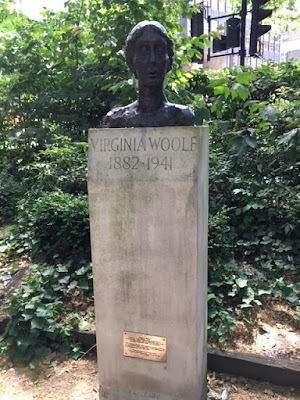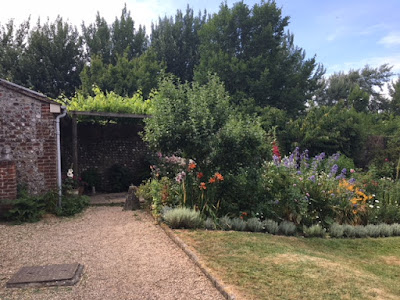 |
| Gordon Square, a quiet park in Bloomsbury, is the perfect place for a picnic or for reading. |
Part of the character of the Bloomsbury neighborhood is its well-preserved charm. The quiet streets are lined with narrow stone apartments, each marked with a bright blue or red door. Trees and parks are plentiful, and while still a busy area, it feels much more relaxed than other parts of the city. One of my favorite things to do in this area is to go "plaque-hunting"; because of the various literary and cultural associations with the area and its historic buildings, there are countless blue and brown plaques on the buildings to mark that X lived here, Y worked here, Z once glanced in this direction . . .
 |
| Plaques like these are everywhere in the Bloomsbury neighborhood. |
Virginia Woolf (then Virginia Stephen) and her sister Vanessa moved to Gordon Square after their father's death. While Woolf wrote that the square was "not one of the most romantic of the Bloomsbury Squares" but that "in October 1904, it was the most beautiful, the most exciting, the most romantic place in the world." So my top priorities upon visiting this neighborhood were strolling through these squares and also finding the plaques and statues that commemorate Woolf and other Bloomsberries.
After my first visit to Bloomsbury, I took a trip to the suburbs of London to see Keats House, a lovely white house in Hampstead where Keats lived for a few years of his short and tragic life. This was where he fell in love with Fanny Brawne after she moved into the adjoining house -- she was, quite literally, the "girl next door." This was also where he wrote works like "Ode to a Nightingale," one of my favorite of his works. In the upstairs bedroom was where Keats first coughed blood and realized that his death by consumption was approaching. He was only 25 when he died, and he was not recognized as one of the world's greatest poets until after his death.
 |
| Keats's study looks a lot like it did in his day. The chairs are even arranged in the same way as in a famous portrait of Keats while he is lost in thought. |
Holly and I also made sure to visit the Charles Dickens House, as he lived in two places near the Bloomsbury neighborhood during his time in London. The house has been converted into a museum, and my favorite part was stepping into Dickens's study. Part of the exhibit was Dickens's writing desk upon which he wrote my two favorite of his novels: A Tale of Two Cities and Great Expectations. When there was no one else in the room, I touched the desk to soak up some literary magic.
Speaking of magic, I took a couple of side trips due to my love of the Harry Potter Universe. I went on a Harry Potter walking tour of the city to see places that inspired J. K. Rowling to write the novels, and we even saw some of the spots used in the films. I made sure to stop at Hardy's candy shop near the street that inspired "Diagon Alley," and it did not disappoint.
I also visited King's Cross Station to see the famous Platform 9 3/4 -- this is quite embarrassing, as I waited in line for about an hour just to get a picture with the trolley and then visit the overpriced Harry Potter shop. It was worth it.
 |
| Was it worth an hour-long wait? You tell me. |










































